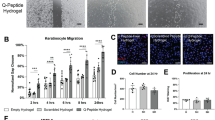Abstract
Proper wound management is an increasingly important clinical challenge and is a large and growing unmet need. Pressure ulcers, hard-to-heal wounds, and problematic surgical incisions are emerging with increasing frequency. At present, the wound-healing industry is experiencing a paradigm shift toward innovative treatments that exploit nanotechnology, biomaterials, and biologics. Here we determined the effectiveness of a radiation-processed hydrogel patch for the delivery of chestnut honey (CH) for the promotion of cutaneous wound healing in diabetic mice. CH is a natural compound that has antioxidant and bactericidal effects. Two full-thickness wounds were made on the dorsal side of diabetic (db/db) mice and the wounds were covered with hydrogel-incorporated CH. Time course observations revealed that mice treated with CH hydrogel showed accelerated wound closure and formation of granulated tissue, enhanced Ki-67 expression and early upregulated HO-1 proteins in the wound region compared with water hydrogel or non-treated mice. Taken together, these findings indicate that CH hydrogel can promote wound healing in diabetics with early HO-1 protein expression.
Similar content being viewed by others
References
JM Rosiak, P Ulanski, Synthesis of hydrogels by irradiation of polymers in aqueous solution, Radiat Phys Chem 55, 139–151, 1999.
A Toksoy, V Muller, R Gillitzer, et al., Biphasic expression of stromal cell-derived factor-1 during human wound healing, Brit J Dermato, 157(6 Suppl), 1148 (2007).
SY Rabbany, J Pastore, M Yamamoto, et al., Continuous delivery of stromal cell-derived factor-1 from alginate scaffolds accelerates wound healing, Cell Transplant, 19, 399 (2010).
DR Knighton, VD Fiegel, GD Philips, Regulation of cutaneous wound healing by growth factors, Clin Mater, 8, 229 (1991).
MNK Chowdhury, AKMM Alam, NC Dafader, et al., Radiation processed hydrogel of poly(vinyl alcohol) with biodegradable polysaccharides, Bio-Med Mater Eng, 16, 223 (2006).
B Fei, RA Wach, H Mitomo, et al., Hydrogel of biodegradable cellulose derivatives. I. radiation-induced crosslinkin of CMC, J Appl Polym, 78, 278 (2000).
JM Rosiak, J Olejniczak, Medical applications of radiation formed hydrogels, Radiat Phys Chem, 42, 903 (1993).
MT Razzak, Zainuddin, Erizal, et al., The characterization of dressing component materials and radiation formation of PVA-PVP hydrogel, Radiat Phys Chem, 55, 153 (1999).
E Alissandrakis, PA Tarantilis, C Pappas, et al., Investigation of organic extractives from unifloral chestnut (castanea sativa L.) and eucalyptus(Eucalyptus globules Labill.) honeys and flowers to identification of botanical marker compounds, LWT-Food Sci Technol, 44, 1042 (2011).
G Beretta, R Artali, E Caneva, et al., Quinoline alkaloids in honey: further analytical(HPLC-DAD-ESI-MS, multidimensional diffusion-ordered NMR spectroscopy), theoretical and chemonetric studies, J Pharmaceut Biomed, 50, 432 (2009).
P Liu, M Zhai, J Li, et al., Radiation preparation and swelling behavior of sodium carboxymethyl cellulose hydrogels, Radiat Phys Chem, 16, 525 (2002).
HH Kim, T Kawazoe, DW Han, et al., Enhanced wound healing by an epigallocatechin gallate-incorporated collagen sponge in diabetic mice, Wound Repair Regen, 16, 714 (2008).
CH Jin, HJ Lee, YD Park, et al., Isoegomaketone inhibits lipopolysaccharide-induced nitric oxide production in RAW 264.7 macrophages through the heme oxygenase-1 induction and inhibition of the interferon-beta-STAT-1 patyway, J Agric Food Chem, 58, 860 (2010).
T Postmes, AEV Bogaard, M Hazen, Honey for wounds, ulcers, and skin graft preservation, Lancet, 341, 756 (1993).
MCBME Vasconcelos, RN Bennett, EAS Rosa, et al., Composition of european chestnut (castanea sativa mill) and association with health effects: fresh and processed products, J Sci Food Agr, 90, 1578 (2010).
M Kucuk, S Kolayli, S Karaoglu, et al., Biological activities and chemical composition of three honeys of different types from anatolia. Food Chem, 100, 526 (2007).
SH Allan, Hydrogels for biomedical applications, Adv Drug Deliver Rev, 42, 3 (2002).
JH Lee, SJ Lim, DH Oh, et al., Wound healing evaluation of sodium fucidate-loaded polyvinylalcohol/sodium carboxymethylcellulose-based wound dressing, Arch Pharm Res, 33, 1083 (2010).
A Grochot-Przeczek, R Lach, J Mis, et al., Heme oxygenase-1 accelerates cutaneous wound healing in mice, Plos one, 4, 6 (2009).
MR Alison, Assessing cellular proliferation: what’s worth measuring?, Hum Exp Toxicol, 14, 935 (1995).
T Scholzen, J Gerdes, The Ki-67 protein: from the known and the unknown, J Cell Physiol, 182, 311 (2000).
S Hsu, WB Bollag, J Lewis, et al., Green tea polyphenols induce differentiation and proliferation in epidermal keratinocytes, J Pharmacol Exp Ther, 3061, 29 (2003).
J Dulak, A Jozkowicz, R Foresti, et al., Heme oxygenase activity modulates vascular endothelial growth factor synthesis in vascular smooth muscle cells, Antioxid Redox Sign, 4, 229 (2004).
A Jozkowicz, I Huk, A Nigisch, et al., Effect of prostaglandin-J2 on VEGF synthesis depends on the induction of heme oxygenase-1, Antioxid Redox Sign, 4, 577 (2004).
A Loboda, A Jazwa, A Grochot-Przeczek, et al., Heme oxygenase-1 and the vascular bed: from molecular mechanisms to therapeutic opportunities, Antioxid Redox Sign, 10, 1767 (2008).
K Patil, L Bellner, G Cullaro, et al., Heme oxygenase-1 induction attenuates corneal inflammation and accelerates wound healing after epithelial injury, Invest Ophth Vis Sci, 49, 3379 (2008).
Author information
Authors and Affiliations
Corresponding author
Rights and permissions
About this article
Cite this article
Choi, D.S., Kim, S., Lim, YM. et al. Hydrogel incorporated with chestnut honey accelerates wound healing and promotes early HO-1 protein expression in diabetic (db/db) mice. Tissue Eng Regen Med 9, 36–42 (2012). https://doi.org/10.1007/s13770-012-0036-2
Received:
Revised:
Accepted:
Published:
Issue Date:
DOI: https://doi.org/10.1007/s13770-012-0036-2




